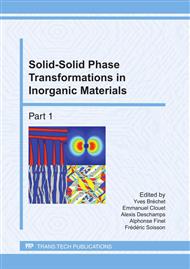p.25
p.31
p.37
p.43
p.49
p.55
p.61
p.67
p.73
Martensitic Transformation and Shape Memory Effect in Titanium-Gold Compound
Abstract:
High temperature shape memory alloys offer numerous potential applications in industrial domains like aeronautics. Even if up to now, none of the studied alloys have found a place in airplane turbines, research in this field is still active. Starting from the well-known “room temperature” shape memory alloy NiTi, it has been demonstrated that the addition of a ternary element such as gold in substitution of nickel greatly enhances the temperatures of the martensitic transformation. In the binary TiAu compound, the martensite start temperature can attain 875 K with satisfying reversibility and cycling stability. From lattice parameters measurements, it has been shown that the maximum transformation strain can reach 10.75 % for Ti47Au53 alloy, which is comparable to that of the NiTi alloy. However, to the best of our knowledge, quantitative measurements of the recoverable strain by shape memory effect are not available in the literature. We present here some quantitative results of shape memory effect associated to this phase transformation in Titanium-Gold alloys measured after compression tests.
Info:
Periodical:
Pages:
49-54
Citation:
Online since:
June 2011
Price:
Сopyright:
© 2011 Trans Tech Publications Ltd. All Rights Reserved
Share:
Citation:


